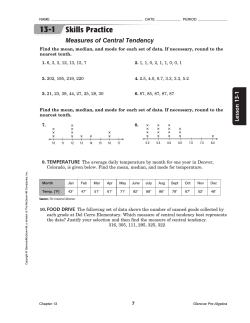
5/13/15 notes Unit 13.6 measures of center and spread
Unit 13.6.notebook May 13, 2015 Example 3 S.ID.2 a) Niles scored 70, 74, 72, 71, 73, and 96 on his 6 geography tests. Objective Student use statistics appropriate to the shape of the data distribution to compare center (median, Find the mean and median mean) and spread (interquartile range, standard deviation) of two or more different data sets b) Raul recorded the following golf scores in his last 7 games 84, 94, 93, 89, 94, 81, 90 Find the mean and median Example 1 Caleb and Kim have bowled three games. Their scores are shown in the chart below a) Find Kim’s average score and Caleb’s average score over the three games and enter it in the table. b) How do their average scores compare? c) Whose scores are more consistent? How far are their scores from their average score? d) If they bowl a fourth game, where Caleb scores 150 and Kim scores a 175. How does this affect their averages? e) Does the Game 4 score affect the consistency of their scores? Explain. Think Pair share Is the average an accurate representation of Caleb’s bowling? Measures of Center: Mean and Median Two commonly used measures of center for a set of numerical data are the mean and median. Measures of center represent a central or typical value of a data set. Yes, Caleb is a consistent bowler, and his scores are all very close to his average. The mean is the sum of the values in the set divided by the number of values in the set. Is the average an accurate representation of Kim’s bowling? No. Kim is an inconsistent bowler and has a fairly wide range of scores. The median is the middle value in a set when the values are arranged in numerical order. Unit 13.6.notebook Think Pair share If you had test scores that were mostly clustered around a particular value, but one score was a lot higher, would you prefer that your teacher report your class grade using the median or the mean of the scores? Explain. May 13, 2015 Measures of Spread: Range and IQR Measures of spread are used to describe the consistency of data values. They show the distance between data values and their distance from the center of the data. Two commonly used measures of spread for a set of numerical data are the range and interquartile range (IQR). The range is the difference between the greatest and the least data values. Quartiles are values that divide a data set into four equal parts. The first quartile (Q 1)is the median of the lower half of the set, the second quartile (Q 2) is the median of the whole set, and the third quartile (Q 3) is the median of the upper half of the set. I would prefer the mean, because the higher score would raise the mean, but it would not affect the median much. Example 4 The interquartile range (IQR) of a data set is the difference between the third and first quartiles. It represents the range of the middle half of the data. Example 5 The April high temperatures for 5 years in Boston are 77 °F, 86 °F, 84 °F, 93 °F, and 90 °F Find the median, range, and interquartile range for the given data set The numbers of runs scored by a softball team in 20 games are given. 3, 4, 8, 12, 7, 5, 4, 12, 3, 9, 11, 4, 14, 8, 2, 10, 3, 10, 9, 7 Find the median, range, and interquartile range for the given data set Why is the IQR less than the range? Example 6 Measures of Spread: Standard Deviation Find the standard deviation of 77, 86, 84, 93, 90. Another measure of spread is the standard deviation, which represents the average of the distance between individual data values and the mean. What is the mean of the deviations before squaring? Use your answer to explain why squaring the deviations is helpful. Unit 13.6.notebook May 13, 2015 Think Pair share Example 7 Find the standard deviation of 21, 31, 26, 24, 28, 26. How do the three measures of spread—range, interquartile range, and standard deviation— differ? How is each one related to measures of center for a data set? The range measures the spread of the entire data set, but it is not based on any measure of center. The IQR depends on the median; it measures the spread of the middle half of the data. The standard deviation measures the spread of the data relative to the mean. Think Pair share Explain the difference between a measure of center and a measure of spread. Use the mean and median to describe and compare the center of data sets. Use the range, interquartile range, or standard deviation to describe andcompare the spread of data sets
© Copyright 2025












